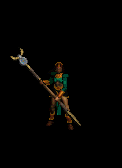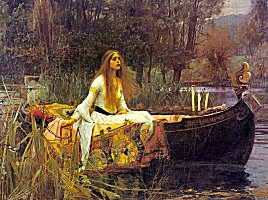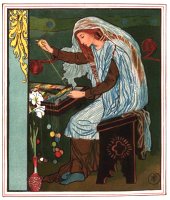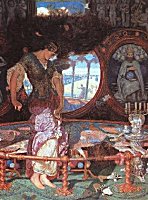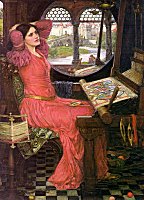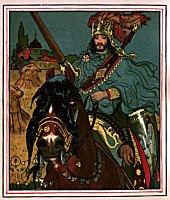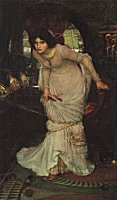Baba
Yaga by Ivan Bilibin
Click
on image for larger version
In
Russian folklore there are many stories
of Baba Yaga, the fearsome witch with
iron teeth.She is also known as Baba Yaga Boney Legs, because, in spite of a ferocious appetite, she is as thin as a skeleton. In Russian that's: 'Baba Yaga Kostianaya Noga'
In some stories she has two older sisters, who are also called Baba Yaga, just to confuse you!
Her nose is so long that it rattles against the ceiling of her hut when she snores, stretched out in all directions upon her ancient brick oven.
Not being a boringly-conventional witch, she does not wear a hat, and has never been seen on a broomstick. She travels perched in a large mortar with her knees almost touching her chin, and pushes herself across the forest floor with a pestle.
Whenever she appears on the scene, a wild wind begins to blow, the trees around creak and groan and leaves whirl through the air. Shrieking and wailing, a host of spirits often accompany her on her way.
Being a somewhat secretive lady, (in spite of all the din she makes,) she sweeps away all traces of herself with a broom made of silver birch (what are brooms for anyway?).
She can also fly through the air in the same manner.
Here's a picture of her flying across the evening sky by Ivan Bilibin:

All
the while it is spinning round, it emits
blood-curdling screeches and will only
come to a halt, amid much creaking and
groaning, when a secret incantation
is said. When it stops, it turns to
face the visitor and lowers itself down
on its chicken legs, throwing open the
door with a loud crash.
The
hut is sometimes surrounded by a fence
made of bones, which helps to keep out
intruders! The fence is topped with
skulls whose blazing eye sockets illuminate
the darkness.
When
a visitor enters her hut, (not too often)
Baba Yaga asks them whether they came
of their own free will, or whether they
were sent. (One answer is the right
one!) Thankfully, she appears to have no power over the pure of heart, such as Vasilisa and those of us who are 'blessed' (protected by the power of love, virtue, or a mother's blessing.)
Baba Yaga rules over the elements. Her faithful servants are the White Horseman, the Red Horseman and the Black Horseman.
When Vasilissa asks her who these mysterious horsemen are, she replies: 'My Bright Dawn, my Red Sun and my Dark Midnight.'
Amongst her other servants, are three bodiless and somewhat menacing pairs of hands, which appear out of thin air to do her bidding. She calls them "my soul friends" or "friends of my bosom" and she is more than a little reticent about discussing them with Vasilisa.
Another strange character who served as a herdsman for Baba Yaga is the sorcerer Koshchey the Deathless. Read all about him here.
And here's a mystery for you: While she is giving instructions to Vasilisa, Baba Yaga mentions that 'someone spiteful' had mixed earth in with her poppy-seeds.
What could she have meant? Could Baba Yaga possibly have an enemy? Would anyone dare to risk incurring her wrath?
Click to see larger pictures
The
White Horseman
The
Red Horseman
The
Black Horseman
(Click
on pictures to see full size images)
In her guise as wise hag, she sometimes gives advice and magical gifts to heroes and the pure of heart. The hero or heroine of the story often enters the crone's domain searching for wisdom, knowledge and truth. She is all-knowing, all seeing and all-revealing to those who would dare to ask.
She is said to be a guardian spirit of the fountain of the Waters of Life and of Death.
Baba Yaga is the Arch-Crone, the Goddess of Wisdom and Death, the Bone Mother. Wild and untamable, she is a nature spirit bringing wisdom and death of ego, and through death, rebirth.































